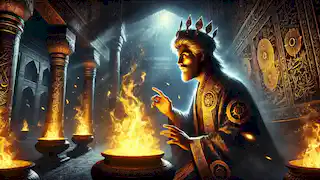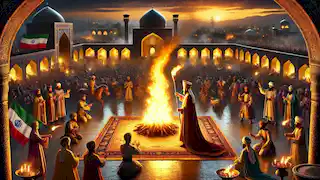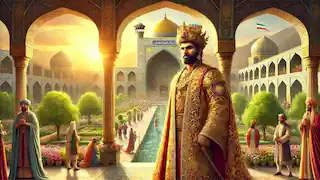Long ago, in the golden age of Persia, before the winds of history scattered the ancient empires, there was a king whose name would echo through the ages—King Jamshid. His reign was the stuff of legends, and his kingdom stretched across vast lands, encompassing all the wonders of the world. He was not only a ruler but also a visionary, revered for his wisdom, his power, and his ability to shape the destiny of his people. Among all the festivals and celebrations during his reign, none were as grand or as meaningful as Nowruz, the New Year, a time when the world would reset and begin again in harmony with the rhythms of the cosmos.
This is the tale of how King Jamshid came to embody the spirit of Nowruz, a festival that still thrives in the hearts of millions today, a reminder of renewal, hope, and the eternal cycle of life. His story is woven with magic, grandeur, and an unbreakable bond between humanity and nature. Once upon a time, when the lands of Persia were still young and the gods still wandered among men, there was a great king named Jamshid. His ancestors had ruled before him, but none had brought the kind of peace and prosperity that he envisioned. Jamshid was a man of unparalleled ambition and vision, and from the very start of his reign, he set out to make Persia a beacon of splendor and civilization. Under his reign, Persia became a land of marvels. He ordered the construction of magnificent palaces that shimmered like jewels in the sunlight, and his cities were filled with gardens that bloomed with flowers from every corner of the earth. But his greatness did not end with the material world. Jamshid was also a master of the spiritual realm. He had a gift—a divine connection that allowed him to see into the future and understand the forces of nature. It was during one of these mystical visions that Jamshid learned the secret of Nowruz. As Jamshid gazed into the sacred fires of his temple, seeking guidance from the gods, a vision took hold of him. In this vision, he saw the earth spinning in a great cycle, the seasons turning in endless repetition, each one bringing life and death in equal measure. He saw that just as the earth renewed itself every spring, so too could the hearts and spirits of his people be renewed. It was in this moment that the idea of Nowruz was born. The gods whispered to Jamshid that Nowruz, the Persian New Year, should be a celebration of life and rebirth, a time when people would gather together to honor the cycles of the earth, the renewal of nature, and the light that triumphs over darkness. It was to be a time of joy, a festival of new beginnings, and a symbol of the eternal harmony between mankind and the natural world. Jamshid was filled with awe and determination. He knew that this vision would transform his kingdom and its people, and he vowed to make Nowruz the most splendid festival the world had ever seen. Jamshid wasted no time in bringing his vision to life. He summoned his architects, artisans, and craftsmen from every corner of his vast empire to create a celebration that would embody the very essence of spring. Under his careful guidance, preparations for Nowruz began. The streets of Persia were adorned with flowers, banners, and lights that shimmered in the spring breeze. Musicians played melodies that echoed the songs of the birds returning from their winter slumber. The people, too, were filled with excitement. They cleaned their homes, dressed in their finest garments, and prepared feasts that would bring families and friends together in joyous celebration. Jamshid himself took on the role of the leader of this festival, ensuring that every detail was perfect. He decreed that the Haft-Seen, a table laden with seven symbolic items, would become the heart of the Nowruz celebrations. Each item on the Haft-Seen table—sabzeh (wheatgrass), samanu (sweet pudding), senjed (dried fruit), seer (garlic), seeb (apples), somaq (sumac), and serkeh (vinegar)—represented different facets of life: health, prosperity, happiness, patience, and wisdom. On the eve of Nowruz, as the preparations neared completion, Jamshid looked over his kingdom from the balcony of his palace. The air was thick with the scent of blossoms and the sound of laughter, and for the first time, he felt the magic of Nowruz stirring in his heart. The dawn of Nowruz broke over the horizon with the first rays of sunlight illuminating the land in gold. It was as if the very heavens were blessing the day with their brilliance. Jamshid, dressed in royal robes embroidered with the symbols of the sun and the stars, led the people in welcoming the New Year. The entire kingdom gathered in the central square, where a magnificent Haft-Seen table stood at the center, surrounded by lush greenery and flowers in full bloom. The people chanted prayers of gratitude for the blessings of the past year and hopes for the year ahead. At the heart of the festival was a sacred ritual: the lighting of the holy fire. Jamshid, holding a torch that had been lit from the eternal flame of his temple, approached the fire pit in the center of the square. As the flames leaped to life, the crowd erupted in cheers. The fire symbolized purity, the triumph of light over darkness, and the eternal renewal of life. For seven days, the celebrations continued. Feasts were shared, stories were told, and music filled the air. People from all walks of life—rich and poor, young and old—gathered to celebrate together, united by the spirit of Nowruz. There was no distinction between class or status during this time; all were equal in the eyes of the New Year. Jamshid's heart swelled with pride as he watched his people rejoice. This was not just a festival; it was the birth of a tradition that would outlive him and continue for millennia. The gods had granted him a gift, and he had given it to his people. But as with all great rulers, Jamshid's reign was not without its challenges. Though Nowruz had brought joy and unity to his people, it also drew the attention of envious forces. Legends speak of Ahriman, the spirit of chaos and evil, who sought to corrupt the beauty of Jamshid's kingdom. Ahriman was jealous of the peace and prosperity that Nowruz brought, and he set his sights on King Jamshid. He whispered lies into the ears of the king’s advisors, sowing seeds of doubt and fear. Soon, Jamshid’s once-loyal counselors began to question his wisdom, and rumors spread throughout the kingdom that Nowruz was a distraction from more pressing matters. Jamshid, ever wise, sensed the dark clouds gathering around him. He knew that Ahriman’s influence was growing, but he refused to let fear guide him. Instead, he sought counsel from the gods once more, asking them how he could protect the festival of Nowruz and his people from the forces of darkness. The gods responded by giving Jamshid a powerful talisman, one that would shield his kingdom from evil as long as the people remained united in their hearts. Jamshid took this talisman and hid it in the heart of the sacred Haft-Seen table, where it would protect the festival for all time. The years passed, and though King Jamshid eventually faded from this world, the legacy of Nowruz endured. The festival of Nowruz became more than just a celebration of spring; it became a symbol of resilience and hope, a time when people could gather to remind themselves of the eternal cycles of life, light, and renewal. Every year, as the vernal equinox approached and the first flowers of spring began to bloom, the people of Persia—and later, people from many lands—would prepare for Nowruz with the same joy and reverence that Jamshid had once inspired. The talisman hidden within the Haft-Seen table remained, a silent guardian of the festival's purity. And though Ahriman and his dark forces continued to roam the world, they could never overcome the power of Nowruz, for it was not merely a day on the calendar but a celebration of the spirit, a reminder that no matter how dark the world became, the light would always return. Today, thousands of years after King Jamshid first lit the fires of Nowruz, the festival remains a cherished tradition in Iran and in many cultures around the world. It is a time for families to come together, for old feuds to be forgotten, and for people to start anew. The Haft-Seen table still graces the homes of those who celebrate Nowruz, and the symbolism of each item remains as powerful as ever. People still clean their homes before the New Year, symbolizing a fresh start, and they still wear new clothes to welcome the spring with open hearts. Just as in the days of King Jamshid, Nowruz is a time to celebrate the cycles of life, to honor the earth and its gifts, and to reflect on the eternal truth that no matter how harsh the winter, spring will always come. {{{_04}}} And so, the tale of King Jamshid and the Spl endor of Nowruz lives on, a story not just of a king and his kingdom, but of the timeless connection between humanity and nature. It is a reminder that we are all part of the same cycle, ever turning, ever renewing, ever hopeful.The Rise of King Jamshid

The Revelation of Nowruz
Preparing for the Festival of Nowruz

The First Nowruz
The Trials of King Jamshid

The Eternal Legacy of Nowruz
The Spirit of Nowruz Today


















